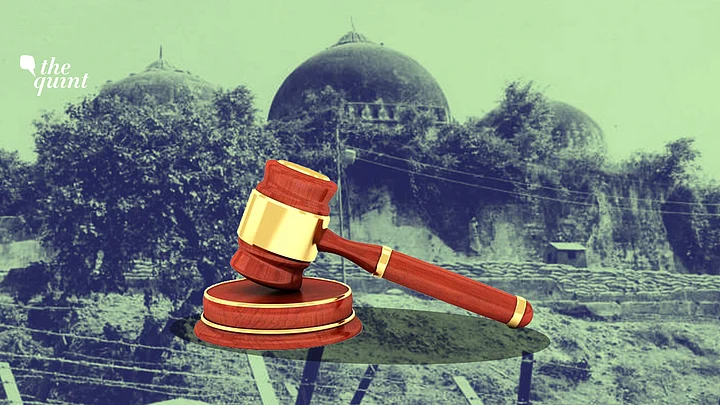“Something there is that doesn’t love a wall.”
When Robert Frost wrote this, little did he know how aptly this would apply to the Indian Supreme Court a hundred years later.
If a finger were to be placed on the one leap of logic absent which the entire reasoning of the Supreme Court unravels, it would be that the court has tried to wish away the grill-brick wall constructed by the British after the communal riot of 1856-57 dividing the disputed property in Ayodhya into two; the inner courtyard and three-domed structure on one side and outer courtyard on the other.
The Supreme Court referred to this wall in its judgement as a “smokescreen” and held that “the disputed site is one composite whole. The railing set up in 1856-7 did not either bring about a sub-division of the land or any determination of title.”
Why Final Outcome Depended on This Key Point
The reason why this becomes key to the final outcome of the decision of the court is that all the evidence that was presented by the Hindus of worship continuing in the outer courtyard since 1856-57 then became evidence that the Hindus were in possession of the “disputed site” as “one composite whole.”
The Muslims had all along admitted worship by the Hindus at the Ram Chabutra, Sita Rasoi and Bhandar located in the outer courtyard.
To this, the court added the additional element that the Hindus, even when praying outside the wall, were actually directing their worship towards the land located inside the wall under the central dome of the three-domed structure, a fact to which some of the Hindu witnesses had testified.
This darshan from across a wall the court extrapolated to be continuing worship inside the three-domed structure by Hindus and eventually in its reasoning elevated it to the level of an element of possession.
Further, the court noted that on three occasions between 1856 and 1949, there had been attempts at desecration of the three-domed structure by the Hindus.
While the record established that each of these attempts was repelled by the Muslims with the aid of the police and civil authorities, the court used this as a third element to show that there was continuous interference by the Hindus with the possession of Muslims of the three-domed structure and inner courtyard.
Quite to the contrary, the conclusion, if any, in law from these was that the Muslims were in fact in exclusive possession of the inner courtyard and three-domed structure and were able to resist, with the aid of authorities established by the British government, any attempt by the Hindus to interfere with their possession.
Muslims Could Prove Continuation of Namaz Since 1856
Therefore, the three elements of the possessory title of the Hindus were (a) continuous worship in the outer courtyard, which ceased to be “outer” once the wall was wished away, (b) the darshan claimed to have been obtained by pilgrims by looking through the grill forming part of the wall and (c) the three attempts made in a hundred odd years to desecrate the three-domed structure.
Against this, the Muslims were able to prove that namaz had been continuing in the three-domed structure and inner courtyard at least since 1856 (since documentary evidence prior to this period was unavailable).
The Muslims also relied upon the fact that they were able to repel any attempts at gaining access to the area on the other side of the grill-brick wall with the aid of the state administration that clearly recognised their exclusive right. On this basis, Muslims claimed possessory title to the inner courtyard and three-domed structure forming part of the disputed premises
The court then applied different yardsticks to the two parties and held that the Hindus were able to show possessory title by worship even from beyond a wall-that-wasn’t and Muslims were not able to establish possessory title since their worship, although on the correct side of the non-existent wall, was not exclusive.
This proposition of law will no doubt have many jealous neighbours looking longingly into their neighbours’ houses in the hope that their unblinking gaze may be recognised in law as an element of title.
On this basis, the court decreed the disputed site in favour of the deity and held that since Muslims have been wrongly deprived of a mosque where they were consistently offering namaz at least since 1856, they should be compensated by giving them land elsewhere.
This relief, the court felt, was best suited to the circumstances as it “preserves the constitutional values of justice, fraternity, human dignity and the equality of religious belief.”
Though the disputed site had been functioning simultaneously as a mosque and a temple on either side of a wall, the Court dismissed this position as not feasible since “The disputed site admeasures all of 1500 square yards. Dividing the land will not subserve the interest of either of the parties or secure a lasting sense of peace and tranquillity.”
This is really the heart of a conclusion driven by considerations of practicality reached by the court by miraculous feats of legal reasoning. Directing a mosque and a temple to once again be constructed on either side of a wall would have caused the dispute to continue to fester.
Robert Frost was certainly wrong in saying “good fences make good neighbours”. Good fences are a figment of our imagination, so are good neighbours.
(Nizam Pasha is a lawyer practicing in the Supreme Court who appeared for some of the Muslim parties in this case. This is an opinion piece and the views expressed above are the author’s own. The Quint neither endorses nor is responsible for them.)
(At The Quint, we are answerable only to our audience. Play an active role in shaping our journalism by becoming a member. Because the truth is worth it.)
